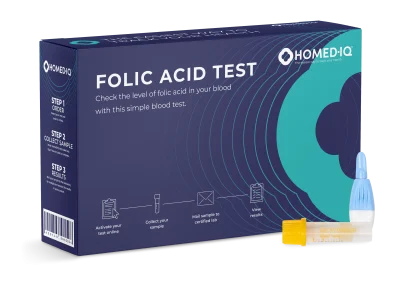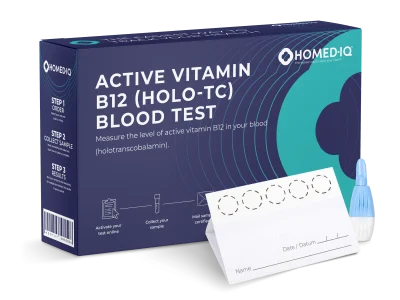Hemoglobin (Hb) is part of the red blood cells in our body. It is important to maintain a healthy hemoglobin level to feel our best and ensure our body can function properly. When our hemoglobin value is too high or too low, physical complaints can arise.
Table of Contents
- What is Hemoglobin?
- Why is hemoglobin important?
- What is an optimal hemoglobin value?
- Causes and symptoms of low hemoglobin
- Causes and symptoms high hemoglobin
- How do I lower/increase my hemoglobin level?
- Summary
What is Hemoglobin?
Hemoglobin is a protein that allows for the absorption and transport of oxygen and carbon dioxide in red blood cells. The red blood cells in our body ensure the delivery of oxygen from the lungs to our body’s cells. Oxygen allows your muscles and organs to obtain energy from the food you eat, also known as cellular respiration. After the oxygen is released to the cells, hemoglobin is then able to absorb carbon dioxide which ends up in the lungs. The carbon dioxide then leaves the body through exhalation (Sanquin, n.d.).
Why is hemoglobin important?
Hemoglobin is essential for various reasons:
- Delivers oxygen: Hemoglobin carries oxygen from the lungs to all body tissues.
- Maintains energy: Adequate hemoglobin ensures cells get enough oxygen to produce energy.
- Supports organ function: Proper oxygen delivery keeps the heart, brain, and muscles working effectively.
- Removes carbon dioxide: Hemoglobin also helps transport carbon dioxide from tissues back to the lungs for exhalation
A hemoglobin deficiency can lead to anemia, a condition where the blood cannot carry enough oxygen to tissues. Conversely, excessively high hemoglobin levels may be a sign of dehydration, chronic lung disease, or other underlying conditions, and can increase the risk of blood clots or stroke.
Because hemoglobin reflects how well your body transports oxygen, it is a key marker in many health checks and blood tests, including complete blood counts (CBCs) and at-home blood tests.
Source: Billett, H. H., 1990
What is an optimal hemoglobin value?
Normal hemoglobin levels vary based on age, sex, and other factors such as pregnancy. They can be expressed in mmol/L (millimoles per liter) or g/dL (grams per deciliter), depending on the country or lab. Here’s a general overview:
| Group | Normal Range (g/dL) | Normal Range (mmol/L) |
|---|---|---|
| Adult males | 13,8 – 17,2 g/dL | 8,5 – 11 mmol/L |
| Adult females | 12,1 – 16,1 g/dL | 7,5 – 10 mmol/L |
| Children > 6 years | 10,5 – 16,1 g/dL | 6,5 – 10 mmol/L |
| Children 1 month – 6 years | 9,7 – 14,5 g/dL | 6 – 9 mmol/L |
Source: Nederlandse Internisten Vereniging, 2020
Values slightly outside these ranges may not indicate a health problem, but persistently high or low values should be evaluated by a healthcare professional.
Causes and symptoms of low hemoglobin
A low hemoglobin level is often a sign of anemia. There are several types of anemia, each with different causes:
- Iron deficiency: The most common form, often due to heavy menstrual bleeding, or chronic blood loss from the stomach or intestines (e.g., ulcers, hiatal hernia, polyps, inflammation). It can also result from low dietary iron intake.
- Vitamin B12 or folic acid deficiency: Usually caused by problems with absorption in the body, but sometimes due to insufficient intake of foods containing these vitamins.
- Chronic disease: Long-term illnesses such as bone marrow disease, kidney disease, rheumatoid conditions, or some forms of cancer can lead to anemia.
- Hereditary forms: Genetic types of anemia, such as thalassemia.
Common symptoms of anemia include:
- Worsening fatigue, sometimes severe
- Shortness of breath
- Dizziness or lightheadedness
- Heart palpitations
- Swelling in the feet
- Ringing in the ears (tinnitus)
- Chest pain, especially with physical exertion
Source: Máxima MC, 2017
Causes and symptoms high hemoglobin
While less common, high hemoglobin levels can occur due to:
- Chronic obstructive pulmonary disease (COPD) (long-term lung disease that makes it hard to breathe)
- Congenital heart disease (heart problems present from birth)
- Emphysema (lung condition where air sacs are damaged, causing breathlessness)
- Kidney cancer
- Liver cancer
- Polycythemia vera (rare blood disorder where the body makes too many red blood cells)
- Pulmonary fibrosis (lung disease that causes scarring and stiffness in the lungs)
Other causes include smoking, carbon monoxide exposure, dehydration, anabolic steroids, erythropoietin-stimulating drugs, and living at high altitude.
Symptoms of high hemoglobin may include:
- Dizziness
- Easy bruising or bleeding
- Excessive sweating (hyperhidrosis)
- Fatigue
- Headache
- Joint swelling
- Unexplained weight loss
- Yellowish eyes or skin (adult jaundice)
Extremely high hemoglobin can increase the risk of blood clots, strokes, or heart attacks.
Source: Cleveland Clinic, 2022
Would you like to get an overview for yourself?
With the Active Vitamin B12 (Holo-TC) Test and the Folic Acid Test from Homed-IQ, you can check from the comfort of your own home whether you have a deficiency of these important nutrients.
-

Folic Acid Test
€45,00 -

Active Vitamin B12 (Holo-TC) Test
€45,00
How do I lower/increase my hemoglobin level?
Managing your hemoglobin levels depends on whether they are too high or too low. Simple lifestyle changes, along with medical guidance when needed, can help bring your levels back into a healthy range. The table below outlines practical steps you can take in each situation:
| Hemoglobin Level | What to Do |
|---|---|
| High Hemoglobin | – Avoid performance-enhancing drugs – Stay hydrated – Eat a healthy diet with fruits and vegetables – Quit smoking |
| Low Hemoglobin | – Take iron or vitamin supplements if prescribed – Eat iron- and vitamin-rich foods (e.g., red meat, liver, fish, leafy greens, beans, nuts, dried fruit) – Maintain a balanced, nutrient-rich diet |
Contact your GP if you require more advice or need to treat the underlying cause.
Sources: Cleveland Clinic, 2022; Cleveland Clinic, 2022
Summary
Hemoglobin is a vital protein that ensures your body gets the oxygen it needs. Both low and high levels can point to underlying health issues, so understanding your numbers is key. While symptoms of abnormal hemoglobin can vary, regular testing and a healthy lifestyle can help keep your levels in check.
References
Cleveland Clinic. (2022, June 20). High hemoglobin count: Causes, testing & treatment. Cleveland Clinic. Retrieved September 1, 2025, from https://my.clevelandclinic.org/health/symptoms/17789‑high‑hemoglobin‑count
Cleveland Clinic. (2022, May 4). Low hemoglobin: Causes, signs & treatment. Cleveland Clinic. Retrieved September 1, 2025, from https://my.clevelandclinic.org/health/symptoms/17705‑low‑hemoglobin
Sanquin. (n.d.). Hemoglobine. Sanquin. Retrieved September 1, 2025, from Sanquin website: https://www.sanquin.nl/donors/alles‑over‑bloed/eiwitten‑in‑bloed/hemoglobine
Billett, H. H. (1990). Hemoglobin and hematocrit. In H. K. Walker, W. D. Hall, & J. W. Hurst (Eds.), Clinical methods: The history, physical, and laboratory examinations (3rd ed., Chap. 151). Boston: Butterworths. Available from https://www.ncbi.nlm.nih.gov/books/NBK259/
Máxima MC. (2017, September 27). Bloedarmoede – Máxima MC. Interne Geneeskunde. https://www.mmc.nl/internegeneeskunde/aandoeningen-en-behandelingen/bloedarmoede/?_ga=2.252499337.1416331597.1669584503-555177933.1667906179
Nederlandse Internisten Vereniging. (2020, January 30). Normaalwaarden ». https://hematologienederland.nl/patientinfo/diagnose-en-behandeling/normaalwaarden/?_ga=2.152885433.1416331597.1669584503-555177933.1667906179






